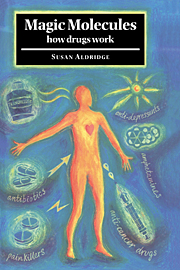Book contents
- Frontmatter
- Contents
- List of illustrations
- Acknowledgements
- Introduction
- 1 How drugs work
- 2 From penicillin to Prozac: introducing pharmaceutical drugs
- 3 Fighting infection
- 4 The hormonal revolution
- 5 Cardiovascular drugs: protecting the heart and brain
- 6 The problem of pain
- 7 The cancer challenge
- 8 Drugs for the mind
- 9 Drugs of recreation and addiction
- 10 Natural alternatives: vitamins, minerals and herbs
- 11 In the pipeline: gene-based medicine
- Bibliography
- Index
4 - The hormonal revolution
Published online by Cambridge University Press: 05 August 2012
- Frontmatter
- Contents
- List of illustrations
- Acknowledgements
- Introduction
- 1 How drugs work
- 2 From penicillin to Prozac: introducing pharmaceutical drugs
- 3 Fighting infection
- 4 The hormonal revolution
- 5 Cardiovascular drugs: protecting the heart and brain
- 6 The problem of pain
- 7 The cancer challenge
- 8 Drugs for the mind
- 9 Drugs of recreation and addiction
- 10 Natural alternatives: vitamins, minerals and herbs
- 11 In the pipeline: gene-based medicine
- Bibliography
- Index
Summary
Hormones are among the most widely prescribed drugs in the world. Unlike antibiotics, they do not attack an invisible enemy. Instead, they intervene in the body's control systems. In the beginning, hormone medicines, like insulin, were used to treat diseases caused by a lack of one or other of the body's natural hormones. Since the 1960s, however, hormone drugs have revolutionised the lives of millions of women around the world by providing for the first time a reliable, long-term, method of contraception. And as these same women approach the menopause, they can now opt to take hormone replacement therapy – a choice which may have a dramatic impact on their health in later years.
The world around us is constantly changing. We tend to attach the most importance to social, political and cultural change, but our bodies have to cope with more basic environmental fluctuations in order to survive for 70 years or more. Enzymes, as we saw in Chapter 1, are the driving force behind the chemistry of life. To function, they need the right temperature, level of acidity, salt concentration, an adequate supply of raw materials and so on within the cells which are their workplace. The body needs to maintain this inner environment in the face of a whole range of outer stresses. Its remarkable ability to do so is known as homeostasis, and it all works through the endocrine system through the action of hormones.
The endocrine system consists of a number of glands (Fig. 4.1) which respond to biochemical signals – such as a fall in blood sugar – by synthesising and secreting tiny amounts of one, or more, hormones into the bloodstream.
- Type
- Chapter
- Information
- Magic MoleculesHow Drugs Work, pp. 91 - 114Publisher: Cambridge University PressPrint publication year: 1998



